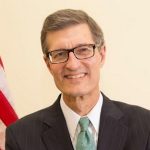 On Monday, February 5, 2018, Andrei Iancu was confirmed by the U.S. Senate to become the next Under Secretary of Commerce for Intellectual Property and Director of the United States Patent and Trademark Office.
On Monday, February 5, 2018, Andrei Iancu was confirmed by the U.S. Senate to become the next Under Secretary of Commerce for Intellectual Property and Director of the United States Patent and Trademark Office.
There are no shortage of opinions about what Director Andrei Iancu should do now that he is at the helm of America’s innovation agency. To contribute to the advice Director Iancu is no doubt receiving from many corners already, I’ve asked a panel of industry experts to weigh and give their advice about what should be on top of the Iancu agenda.
 Bob Stoll
Bob Stoll
Partner, Drinker Biddle
To ensure a successful tenure as Director at the USPTO, Andrei Iancu needs to listen. Nothing is more important at this early stage than to collect input before launching in any particular direction. I am sure the incoming Director has been listening during this interim period, but now he needs to do it more publicly and more broadly. He must hear from all of the agency’s constituency groups both internal and external. It is critical to his success that he is perceived as being fair and listening to everyone.
Director Iancu will learn that his ability to move most managers in the short term is limited, as it should be. He will learn that the Federal Advisory Committee Act (FACA) will make establishing any “kitchen cabinet” nearly impossible. And he will learn that both the unions and the user groups have entrenched ideas how everything needs to be done. I am certain Director Iancu will want to tackle problems on subject matter eligibility, PTAB rules and quality, but rule-making in an agency is rigorous and takes time. Be assured that no matter what direction he takes on the numerous issues before him, there will be winners and losers. And in ultimately making his decisions, it is important to clearly address expressed concerns and to be as balanced as possible.
For now, start by listening to everyone!
Robert L. Stoll is a partner at Drinker Biddle and former Commissioner for Patents at the United States Patent and Trademark Office. The opinions expressed here are his own.
Alden Abbott
Heritage Foundation
As I explained in a Heritage Foundation Legal Memorandum, Americans’ legitimate patent rights have been undermined in recent years, due to the combined effect of Supreme Court decisions that made it harder to obtain and defend patents; a new patent-skeptical administrative tribunal, the PTAB (Patent Trial and Appeal Board), that has struck down numerous promising patents; and Obama Administration policies that had the effect of weakening respect for patents. (Reflecting this reality, the U.S. patent system dropped to number twelve in the world, tied with France, in the just-released U.S. Chamber of Commerce Global IP Intellectual Property Index for 2018.)
Newly confirmed PTO Director Andrei Ian?u will have the opportunity to redirect policy toward the strengthening of respect for patent rights, and intellectual property (IP) in general. He should do so by working to gain Trump Administration support of appropriate patent legislative reform (while also pursuing PTO-specific regulatory improvements) and by leading an interagency Administration IP Working Group.
First, legislation and PTO regulatory improvements. Bipartisan legislation introduced last year by Senators Chris Coons (D-Del.) and Tom Cotton (R-Ark.), the SMARTER Patents Act, would, among other things, rectify PTAB’s most serious due process-related deficiencies and restore the presumption that patent holders are entitled to an injunction upon a judicial finding of patent infringement. By working to obtain a strong Administration endorsement of the SMARTER Act (or of the key principles it embodies), Director Iançu would substantially raise the likelihood of its enactment, and signal the Administration’s commitment to rectifying PTAB-related harm.
As he rallies support for SMARTER Act principles, the Director simultaneously should direct that PTAB (which is under his jurisdiction) undertake reforms to strengthen due process, protect against conflicts of interest on the tribunal, and eliminate all implicit “anti-patent” bias reflected in its proceedings. Director Iançu should also study legislative proposals for targeted reforms to the Patent Act (see here, for example), aimed at overturning Supreme Court decisions that have limited the scope of patentable subject matter and thereby reduced the value of patenting initiatives. Simultaneously, on the administrative front, the Director should evaluate patent examination practices to ensure that recent Supreme Court decisions are not “over-read” to limit patentable subject matter more than is legally required.
Second, IP Working Group. Director Iançu should secure Administration support for a White House–led interagency Working Group on Patents, chaired by the PTO Director and including senior representatives from key federal agencies, including the Justice Department. The Working Group should be directed to study laws, regulations, and policies that affect patent rights, and recommend reforms as appropriate. Justice Department Assistant Attorney General for Antitrust Makan Delrahim could play a key role in working to reverse the Obama Administration’s antitrust policies that undermined patent rights (see Delrahim’s recent speech signaling a move away from misguided Obama Administration antitrust policy that weakened patent protection). Significantly, the Reagan Administration convened a similar Working Group on IP Policy, chaired by then-PTO Director Gerry Mossinghoff, featuring significant Justice Department involvement. That Working Group was instrumental in promoting more robust protection for patents and other IP rights in federal legislation and regulation, and in actively disseminating the Antitrust Division’s repudiation of its longstanding “anti-IP” policy orientation (a repudiation that bore substantial fruit in subsequent federal antitrust case law precedents).
In sum, by vigorously pursuing reforms along the lines suggested above, Director Iançu could make PTO a leader in the advancement of American innovation, which depends critically on a strong patent rights system.
Alden Abbott serves as Deputy Director of Edwin Meese III Center for Legal and Judicial Studies at The Heritage Foundation.
 Stephen Kunin
Stephen Kunin
Partner, Oblon, McClelland, Maier & Neustadt, L.L.P.
Here is my short list of 5 priorities for the new Director of the USPTO: (1) Ensure adequate funding for the Office, including efforts to avoid diversion of user fees to other federal government activities. (2) Address concerns regarding how the PTAB AIA trials are managed to improve consistency in decision making and make them more fair and balanced. (3) Leverage Global Dossier to reduce duty of disclosure obligations regarding prior art and office actions in foreign counterpart application. (4) Adjust PTO rules to remove requirements to disclose personal information protected by the EU General Directive on Privacy Rights effective March 2018. (5) Support patent subject matter eligibility reform to ameliorate the adverse impacts of the Mayo/Alice decisions on the software and personalized medicine industries.
Stephen Kunin serves as an expert witness and consultant on patent policy, practice and procedure. Mr. Kunin served three decades at the USPTO, including 10 years as Deputy Commissioner for Patent Examination Policy.
 James Edwards
James Edwards
CEO, ELITE Strategic Services
Director Iancu’s first task is to stop the bleeding of patent property rights that the PTO is inflicting. In that vein, he should halt all PTAB proceedings of patent validity challenges and order a top-to-bottom review and overhaul of its rules, policies, procedures and ethics. Ending broadest reasonable interpretation of patent claims, requiring standing in order to request an inter partes or other postgrant review as well as PTAB deference to a judicial finding of a challenged patent’s validity, limiting challenges to the same patent to one time only on any given claim or by any given petitioner, placing a reasonable, short time limit (e.g., two years) on validity challenges against an issued patent, and insisting on strong presumption of patent validity, and fairness and due process — like barring panel-stacking to get a predetermined outcome — would make a good first set of reforms.
He should simultaneously direct patent examiners to interpret broadly patent-eligible subject matter within the plain meaning of Section 101 — you know, “discoveries,” the term used in the Constitution, again having meaning. These two steps would apply a tourniquet to the injury the PTO is causing. By this, Mr. Iancu would signal that the PTO’s primary constituency is once more inventors and intellectual property owners. And he would begin to help reverse the slide indicated in the U.S. Chamber of Commerce’s latest International IP Index, which has seen the United States fall to 12th place, tied with that invention powerhouse Italy.
James Edwards consults on intellectual property, health care innovation, and regulatory and policy issues. Among other clients, Edwards advises the nonprofit group Eagle Forum on patent policy and is Co-Director of the Inventor’s Project.
 Bruce Berman
Bruce Berman
Brody Berman Associates
As an experienced patent litigator, Director Iancu has been on various sides of complex issues. He has represented a variety of defendants and plaintiffs and is uniquely equipped to understand the weaknesses and strengths of the IP system like few before him. PTAB decisions have served to muddy the reputation of the USPTO because they have frequently been biased and politicized. Director Iancu is in the position to review the Board’s processes and to make changes where necessary. He can address issues that his predecessors failed to.
If the PTAB is here to stay, it must be made a credible and consistent body that can be trusted not only to invalidate patents which should not have been issued, but to improve those that need to be, and affirm those that deserve to be.
Bruce Berman is principal of Brody Berman Associates, a management consulting and IP communications firm. In 2016, Bruce founded the Center for Intellectual Property Understanding, an independent, non-profit that focuses on IP awareness and attitudes.
 John White
John White
Partner, Berenato & White
What should Iancu do?
(1) Sit down with Dave Kappos and Bob Stoll and Drew Hirshfeld and get to know what it is to run the PTO day to day (examination and policy), and year to year (money, money, money). Spend several hours; get to know the issues, and the levers that operate the enterprise. (2) Meet the Union rep(s) for POPA off-site, just as Kappos did, and get the Union perspective, unfiltered by senior PTO staff. (3) Believe in your product. (4) Believe in your staff to deliver that product. (5) Eliminate impediments to (3) and (4). (6) Meet with the Board and learn the Politics of that entity. (7) Rid them of those politics. (8) Get and keep the fees paid to the USPTO. (9) Use those funds to eliminate impediments to (3) and (4). (10) Include, as a part of annual examiner training, searching training to find the best prior art that exists, across the globe, in each examination. The best and most powerful tools, using the best and newest training, will yield the best prior art. (11) Enjoy yourself, and give talks that indicate the pride you have in the system you oversee. Be a proponent of the patent system. (12) Call me, if any of this is confusing.
Mr. White is a US patent attorney with Berenato & White, and a principal lecturer/author of the PLI patent bar review. Since John began teaching patent bar review courses in 1995, he has personally taught nearly 50% of all practicing patent attorneys and patent agents how to successfully become admitted to the Patent Bar.
 Farzad Amini
Farzad Amini
Womble Bond Dickinson
From my experiences, I would like to see Director Iancu take a look at the process for rejecting claims for lacking any patent eligible subject matter (also known as Alice rejections, named after the US Supreme Court decision in Alice Corp. vs. CLS Bank Int’l which limited scope of patent-eligible subject matter.) In many instances, these Alice rejections are overcome quickly and without much dispute, but they create delays and added expenses for clients.
The new Director should therefore have the examiners’ subject matter eligibility guidelines reviewed and revised to require stricter and consistent standards for making such rejections, while of course remaining consistent with the current law in Alice. That would help focus the patent examination task on the core issues that are of concern for patent owners, namely how to improve patent quality in a cost-efficient manner.
Farzad Amini is a partner in the Los Angeles Office of Womble Bond Dickinson. Farzad is a member of the Patent Practice Group. As a registered patent attorney, Farzad’s primary practice area includes all aspects of drafting and prosecuting patent applications in the electrical and mechanical fields.

 Josh Lorentz (left) and Oleg Khariton (right)
Josh Lorentz (left) and Oleg Khariton (right)
Dinsmore & Shohl LLP
PTAB reform, particularly with respect to post-grant proceedings, is likely to be near the top of Director Iancu’s list of priorities. One area that many feel needs improvement is the predictability of decisions. Because very few PTAB decisions are precedential, parties cannot always expect consistent outcomes on certain recurring issues of law. One of the reasons behind the low number of precedential decisions is that the PTAB’s Standard Operating Procedure (SOP1) for designating a decision as precedential can be cumbersome, requiring a majority vote of hundreds of APJs. Streamlining that procedure to allow more decisions to be designated as precedential would be one way to improve consistency. Another related issue that warrants attention is the PTAB’s use of expanded panels. Although panel expansion can be a useful mechanism for enhancing consistency (since decisions by expanded panels are treated as de facto precedential), the practice has recently attracted criticism, including from the Federal Circuit. Whether fully warranted or not, such concerns deserve careful consideration. Finally, the public needs to receive meaningful guidance with respect to motions to amend following the Federal Circuit’s decision in the Aqua case. That decision, which upended the PTAB’s old rules, was handed down in October. A lot of questions still remain as to how motions to amend will be treated post-Aqua. It is imperative that the PTAB provide some certainty in the coming months.
Josh Lorentz is chair of Dinsmore & Shohl LLP’s Intellectual Property Department and practice group chair of the firm’s IP Litigation and Licensing Practice. Oleg Khariton is a member of Dinmore’s Intellectual Property Department, focusing his practice on patent litigation.
 Thomas D. Franklin
Thomas D. Franklin
Kilpatrick Townsend & Stockton LLP
I think Andrei should focus on those vestiges of our patent system that are expensive to inventors, but add little value in the grand scheme of things. I don’t care about international conformity, but suggestions put the US in line many foreign countries so are not earth shattering and are tested overseas. BTW: Usual caveat in that these are my personal opinions and not anything to do with my firm who might take contrary positions.
First, a substantial cost to prosecute a patent application is borne by the applicant in getting confirmatory assignments and declarations. This is even more difficult for continuations years later when our more mobile workforce has likely moved to a new job. All the effort to gather these documents is especially unnecessary in the first to file system where we removed the bickering over a fundamentally subjective determination. I pity the patentee who shows up in court who isn’t the owner of the patent so they are incentivized to be the owner without need for the regulatory burden.
We have millions of patents that are in-force that are all burdened with this unnecessary effort with only thousands ever being contested. My proposal would be to only have to argue about the few hundred of the few thousand being litigated that might have an ownership issue. Applicants would still be encouraged to register assignments, but declarations would go away. For the small amount of patents being prosecuted where there might be a disagreement about ownership, the courts could decide those or the PTO could have an administrative procedure to determine the applicant.
Second, duty of disclosure is an antiquated requirement in the age of modern search tools and global dossiers to share search results. Studies have shown that examiners rarely rely on applicant prior art anyway. Related cases are readily identified to Examiners as could the foreign prosecution in global dossiers. Redundantly submitting this is expensive and unnecessary regulation that increases the expense of protecting innovation.
Applicants would still be encouraged to submit prior art, but the requirement would be lifted. The duty of disclosure adds significantly to the cost to manage cross-citing and submission of large amounts of references. To the extent that Examiners cannot automatically get the art from related cases and foreign equivalents, that technology is readily available from commercial search firms.\
Third, color drawings and photos should be allowed in patent filings. The rules on drawings are from a paper and pencil era that ended decades ago. PDF submission of clear color drawings and photos should be allowed through e-filing where no scanning or analog degradation would happen. One argument against use of these types of drawings was the reproduction difficulties. Now that nearly all patents are accessed electronically, the requirement makes no sense. The increased costs for formalizing existing drawings unduly burdens applicants.
Fourth, when the fast track 1 patents began there was discussion of a slow track too. Many thinly funded companies or emerging technologies would benefit from the delay of examination. Those costs can be greater than the writing costs or government fees. By allowing delay, developing technologies that might be orphaned or unneeded with the clarity of time could avoid burdening the PTO to examine what is useless technology. Where a slow track case becomes commercially interesting, examination could be requested perhaps even on the fast track. An infinitely extendible missing parts deadline could accomplish this, but it might be capped at 7 years or something or require annuities after some point.
Fifth, many countries have the option of a petty patent that is not examined substantively. We have a large discrepancy between examination in the Office and litigation of the same patent such that examination is of dubious value. Plus, only a few thousand patents of the millions examined are ever litigated. Applicants would be encouraged to write good applications and valid claims perhaps with their own validity searching. It would align applicant interest with their effort to elegantly incentivize great petty patent applications with those best suited to draft them for court room validity. There could be a PTO proceeding to examine the petty patent prior to court enforcement which would focus examination only on those cases that might be litigated.
Thomas Franklin is a partner with Kilpatrick Townsend & Stockton LLP. Mr. Franklin focuses his practice on patent prosecution, licensing and intellectual capital management with more than fifteen years of experience with intellectual property. Recognized by Chambers USA, sources noted Mr. Franklin as “a brilliant and intelligent attorney who knows IP law inside out.”

![[IPWatchdog Logo]](https://ipwatchdog.com/wp-content/themes/IPWatchdog%20-%202023/assets/images/temp/logo-small@2x.png)


![[Advertisement]](https://ipwatchdog.com/wp-content/uploads/2024/04/UnitedLex-May-2-2024-sidebar-700x500-1.jpg)
![[Advertisement]](https://ipwatchdog.com/wp-content/uploads/2024/04/Artificial-Intelligence-2024-REPLAY-sidebar-700x500-corrected.jpg)
![[Advertisement]](https://ipwatchdog.com/wp-content/uploads/2024/04/Patent-Litigation-Masters-2024-sidebar-700x500-1.jpg)

![[Advertisement]](https://ipwatchdog.com/wp-content/uploads/2021/12/WEBINAR-336-x-280-px.png)
![[Advertisement]](https://ipwatchdog.com/wp-content/uploads/2021/12/2021-Patent-Practice-on-Demand-recorded-Feb-2021-336-x-280.jpg)
![[Advertisement]](https://ipwatchdog.com/wp-content/uploads/2021/12/Ad-4-The-Invent-Patent-System™.png)






Join the Discussion
33 comments so far.
Stuart Saunders
March 29, 2018 09:56 pm1) Create a non destructive patent system like the ‘One Dollar Patent System’ @ http://www.iproag.org.
Stop the patent system killing inventions, and the odd inventor.
Possibly save the planet as well – by encouraging inventors to bring out their hidden inventions, hidden because of the paranoia in extremis induced by fraudulent ‘absolute novelty’.
Pardon me for expressing an inventors opinion.
Anon
February 20, 2018 09:32 pmMr. Heller,
Your post has no meaning. Until you realize that your attempts at parsing “novelty” into the 101 equation are nothing more than reflections of a wayward and broken scoreboard, none of your protests carry any persuasive value.
You are – irretrievably – broken with a comment like “Simply being programmed does not improve a computer, but a programmed computer in a larger system can improve that larger system.”
Shear madness, that be.
“But it also suggests that it unless the improvement to technology is clear, that a case can be disposed of in prosecution under 101 without a search.”
You are truly deeply and madly befuddled. What part of the Office being responsible for the prima facie case – including the appropriate level of evidentiary support now unfolding escapes you and prompts an inane comment like no search is even necessary?
Edward Heller
February 19, 2018 12:43 pmAnon, when the meaning of the words is the novelty, as opposed to the physical relationship of the printing to the underlying substrate, whether the meaning of the words is new or nonobvious is irrelevant.
Alice and its brethren seek to find a new or improved machine, etc. This requires some improvement in functionality. Simply being programmed does not improve a computer, but a programmed computer in a larger system can improve that larger system.
Thus it might be advisable for the Office to determine whether the otherwise ineligible subject matter in the claim operates to improve a larger machine such as a computer system, before conducting the novelty and obviousness analysis. The example we all know of is the programmed computer in Diehr that was executing a program computing the Arrhenius equation. That equation was not only ineligible, it was not even new.
In line with the topic as thread, whether there is an improvement to the computer system itself is a question of fact. It would help applicants if the improvement to the computer system were clearly set forth in the specification. But it also suggests that it unless the improvement to technology is clear, that a case can be disposed of in prosecution under 101 without a search.
Anon
February 19, 2018 10:55 amMr. Heller,
Your view of the exception to the judicial doctrine of printed matter is not correct.
It is not that each instance – in and of itself – must be a new functionality for the exception to inure.
There is NO requirement for the “new way in modifying the functionality” as you attempt to spin here.
That would be directly akin to requiring a new way of configuring elementary particles into atoms, or a new way of configuring atoms into molecules in order to obtain a patent on anything comprising atoms or molecules,
Such it utter rubbish, as I am more than sure that you are aware.
Rather, when understanding the exceptions to the judicial doctrine of printed matter, it is simply sufficient that the aspect of “functionally related” be present.
Software – being a “ware” has that TYPE of functionality.
Further, here, with your attempted step from novelty to “not even get to 103” appears to be nothing more than muddling.
You again seek to impose some type of parsed>/I> “Point of Novelty” for the 101 sense, and – as has been explicitly pointed out to you numerous times – that view has no grounds in the law written by Congress in the Act of 1952.
Please desist from what is clearly an improper attempt to change the meaning of the law.
Edward Heller
February 17, 2018 02:12 pmanon, printed matter is excluded because it is non statutory unless it provides new functionality to the otherwise statutory elements of a claim. Printed matter, unless so functional, is given no weight in the novelty analysis. We do not even get to 103.
What I am suggesting here is that the Office identify non statutory subject matter and not examine it for novelty unless the applicant demonstrates in some fashion that it modifies in a new way the functionality of the underlying otherwise statutory subject matter.
Anon
February 17, 2018 12:30 pmMr. Heller, exceptions to the judicial doctrine of printed matter.
Again, please stop and check yourself.
The claim – as a whole – is what is to be viewed at as far as eligibility goes and NOT some parsed “Point of Novelty” as you would attempt to apply that to the eligibility legal requirement.
There is simply NO legal requirement that ANY individual claim element – in and of itself – is necessarily constrained to be “eligible subject matter” as you attempt to portray the law.
That is clear legal error, and as an attorney, you should know better.
(likewise, your known tangents into “music” are simply inappropriate and do not make the legal point that you think that you are making with such comments)
Edward Heller
February 17, 2018 11:58 amanon@25, printed matter doctrine.
Anon
February 17, 2018 09:02 amMr. Heller, your view is simply NOT in accord with law, and is merely your tired attempt to insert some odd “Point of Novelty” aspect into 101 and to NOT take the meaning of the invention as the claim as a whole.
Please stop and check yourself.
Edward Heller
February 16, 2018 12:46 pmMay I politely point out that the novelty of the ineligible subject matter is a relevant to the patentability of a claim. Thus, forcing the examiner to examine for novelty purposes subject matter in the claim that is not otherwise eligible is a waste of resources.
Maybe I’m Amazed
February 16, 2018 12:31 pmRegarding Paul Morgan’s first question/comment to:
“Would not many of problems with 101 rejections of patent applications be greatly reduced, and patent quality improved, if 101 rejections could no longer be used in first action rejections – only genuine 103 and 112 actions after genuine prior art searches?”
The strict Office policy is to compact prosecution. All possible rejections MUST be made in the first Office Action. That necessarily means 101 as well. A complete search must thereby be made as well and is mandatory. So if a 101 only rejection is being made there should be a statement to the effect that the claims are otherwise allowable should the 101 rejection be overcome.
Night Writer
February 13, 2018 09:59 pmFranlin : such that examination is of dubious value.
So, I think this is kind of true. With IPRs, one wonders why even prosecute a patent application.
AAA JJ
February 13, 2018 09:46 amMr. Franklin’s suggestions are excellent. Maybe he should be the Director.
Kevin Rieffel
February 12, 2018 05:32 pmI’m sick of hearing that inventors only get patents granted because the poor, overworked examiners are prone to falling asleep at the wheel. Paying for USPTO fees and legal bills on 2+ RCEs and/or an appeal is hardly “sneaking one passed the goalie.” So let’s make a concerted effort to free up their time:
The Office needs to develop an examining tool–e.g., featuring AI and machine learning–that helps automate 102/103 rejections by roughly mapping claim elements to prior art. It will never be perfect, but maybe it can cut down the time, especially if you allow access for inventors/practitioners to get more bites at the apple and offer fruitful amendments.
Clinton Gallagher (@tapABILITIES)
February 12, 2018 12:29 pmThe USPTO like all other agencies and departments has become flooded with swamp water. USPTO Director Andrei Iancu needs to address that.
As a trademark applicant well groomed in reading and appying the law when working as an architect I was shocked to observe the USPTO examiners have allowed a specific company to register marks which are unlawful. That company caused my startup a great amount of grief, costs and lost time and continues to this day to use generic trademarks and fraudulent declarations in the record to bully and harrass its maintainance of the oligopoly it has in global financial payment markets which so happen to use the same wireless networking protocol to convey data as many, many, many other companies use to wirelessly communicate.
Furthermore, no pun intended, in this context it is patently unjust to put the onus on the applicant whose only recourse are opposition or cancellation proceedings which are and can be exceedingly costly and time consuming when the matter at hand is the observation that examiners are at fault.
Apparently as I was displeased to learn there is no over-sight, review or other auditing process within the USPTO when applicants with the sincere belief and understanding come to learn that examiners themselves are not abiding by the rules as put forth in TMEP and other such resources.
I urge Director Andrei Iancu and other attorneys of character to support this endeavor to drain the swamp so to speak and establish the means of due process auditing of the work of the USPTO examiners themselves.
Frank Coppa
February 12, 2018 11:23 amAgree with a previous commenter; a good collection and wish-list. Also, control of PTO costs should accompany any large initiatives. The latter are often used to justify nasty hikes in fees, down the road if not short-term.
Joachim Martillo
February 12, 2018 11:23 amThe minions of Trump wasted out time with FISA nonsense in the House Intelligence Committee when the House Judiciary Committee should be investigating the USPTO for agency capture and corruption.
Joachim Martillo
February 12, 2018 11:15 amHyatt’s applications were illegally flagged in SAWS.
Opening up the internal files so that USPTO senior officials that created SAWS and other illegal secret programs can be charged, arrested, and tried as they are terminated from US government employment is a much better solution to USPTO criminality and ultra vires policy making.
Mincing words about USPTO criminality and corruption is no solution to US patent system problems at all.
Gene Quinn
February 12, 2018 11:09 amRichard-
Yes. I attempted to get a diverse perspective as I always do. I have a growing list of people who make up my “go-to” panel for these types of industry inquiries, and there are women on that panel. I publish whatever I receive.
-Gene
Paul Morgan
February 12, 2018 10:58 amAt very low cost the dangers to established U.S. industries of new generic claims written 10 or more years after an applications original [priority] filing date should be reduced to a minimum by prompt high priority special attention to any application with a more than ten year old claimed original filing date. PTO avoidance of prompt action on Hyatt and other “submarine” applications is inexcusable.
Paul Morgan
February 12, 2018 10:50 amWould not many of problems with 101 rejections of patent applications be greatly reduced, and patent quality improved, if 101 rejections could no longer be used in first action rejections – only genuine 103 and 112 actions after genuine prior art searches?
Respect Patents
February 12, 2018 09:33 am1. Reform the PTAB today.
2. Focus on #1 for the next few years.
The bar to institute an IPR must be high. PTAB is designed to swiftly correct USPTO errors. Instead, it has become a weapon to destroy the best U.S. patents. Imagine. If an IPR is instituted in limited cases the District court case can proceed with some level of confidence of validity and focus on infringement.
Anon
February 12, 2018 09:00 amJoachim,
I applaud your comments.
More – rather than less – sunshine is needed. It is unfathomable to me how “SAWS” appears to have been swept under the rug, as if that one program were the only program operating in the shadows (quite in conflict with the admission by the USPTO when they finally ran out of shadows to hide in regarding SAWS and admitted that THAT program did in fact exist – their comment included the admission that SAWS was but one of MANY such “quality programs.”
Night Writer
February 12, 2018 08:23 amNarrowly, to improve prosecution, I would suggest performing a search like the EPO does before examination. And, using the results of the search to assign the patent application to the right person.
Biggest problems with prosecution: search needs to be improved and the assignment of the patent applications needs to be to the right examiner.
Do those two things and quality will soar.
Joachim Martillo
February 12, 2018 08:06 amIancu should make all the internal documentation of secret unlawful programs like SAWS to be available for public inspection and analysis. Crooked USPTO officials have used the aforesaid programs and the AIA post-grant review proceedings to steal IP and to put it in public domain.
I have been looking at agency capture and corruption since 2006 (mostly as a result of involvement in complex litigation at two major law firms). Serious criminality seems to go back to 1994 either as a reaction to In Re Alappat or as anticipation of the GATT changes, which thanks to publication rules turns application disclosures of previously secret IP into low-hanging fruit.
After processing released internal USPTO materials, I should be quickly able
1) to identity the rest of the crooked USPTO senior officials along with their APJ co-conspirator button men and
2) to bring crimes of this roach-like group to the attention of the FBI and of the SEC.
Iancu should operate on the assumption that as a political appointee he won’t head the USPTO for a long time. While the importance of the USPTO works over centuries, Trump and his appointees look like short-termers. I don’t really care about transitory politics, but Iancu has to worry about time scale.
Identifying the crooks so that they can be indicted and terminated from employment may be the quickest way to clean house for meaningful change at the USPTO for the good of the USA.
Richard
February 12, 2018 05:39 amGene, did you survey any women (diverse women as well)?
angry dude
February 11, 2018 10:23 pmdismiss all the PTO stuff and turn the lights off on his way out …?
you don’t get the real picture in your heads, dudes
IF US patent system is “fixed” guys like me will come out of woods and bring the most “valuable” tech companies in US to their knees…
begging for patent license…
not kidding here
remember NTP vs RIM?
and that was all mostly about bs patents anyway
Anon
February 11, 2018 05:02 pmI would quibble with several of the suggestions (for various reasons), but find myself resonating deeply with John White’s list. I think that list would provide the most bang for the buck.
Edward Heller
February 11, 2018 03:39 pmAlong with no diversion of user funds, I would also like to see a substantial increase in Public funding of the PTO in order that user fees might be reduced. I know this is going to be a non-starter given the current budget situation of the U. S. government. But I remember the day when there were no maintenance fees and filing/issue fees were ridiculously low by comparison with today’s fees. Things have gotten away out of hand in terms of fees in my humble opinion.
Judge Rich’s Ghost
February 11, 2018 02:50 pmWhat’s with the sausage party?
Anon
February 11, 2018 10:25 amGene,
A great collection and one I will “listen to” first before providing any comments on the substantive nature of advise to Mr. Iancu.
Edward Heller
February 11, 2018 09:47 amName, I am not surprised that the PTAB has turned nasty to applicants as well as to patent owners. I am sure no one is surprised.
Name withheld to protect the innocent
February 11, 2018 09:16 amDirector Iancu will want to tackle problems on subject matter eligibility, PTAB rules and quality, but rule-making in an agency is rigorous and takes time.
You don’t need “rule-making” to address many of those issues.
As for subject matter eligibility, how about a strict adherence to MPEP 2106, which now incorporates many of the USPTO Guidance memos issued over the past few years? There are some art units and tech centers (I’m looking at you TC3600) that think that just because a patent application is in their art unit it is automatically directed to non-statutory subject matter. There are many examiners there who have issued nothing more than a handful of patents (if any at all) over the last 3 years.
Also, improved quality doesn’t require rule making. It merely requires high expectations and consequences for not meeting those expectations. There are many at the PTAB that appear to think that ex parte appeals is a game — let’s see how we can butcher the facts/law to affirm the examiner. In FY2018, Appeals are being affirmed at a 58.3% clip. In FY2000, that number was 29.2%. I can assure you that the quality of examination has not improved that much. Instead, the PTAB has gone from a place where you could expect a fair shake to a tribunal that bends over backwards to support any position presented by an Examiner. As best as I can tell, that 58.3% is the all-time highest at the USPTO.
Edward Heller
February 11, 2018 08:48 amA simple fix that would force fairness in all post grant proceedings, including reexaminations, is to require patent owner consent.